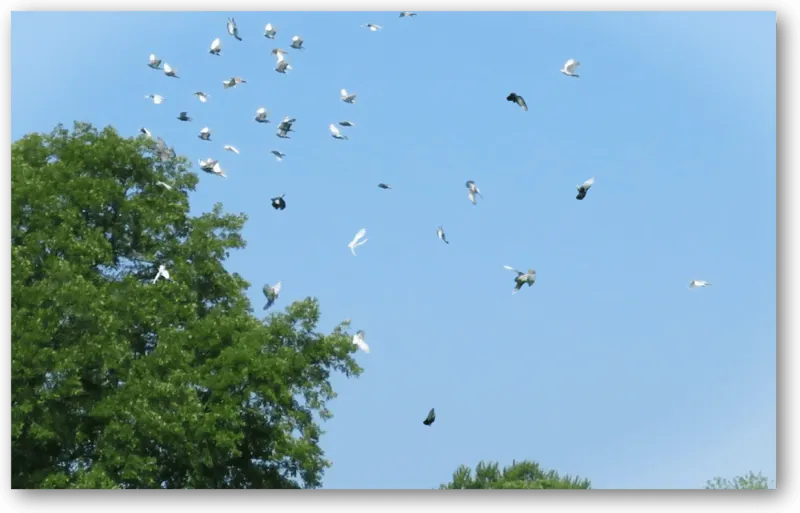In this article, I will do my best to describe various conditions and situations that may arise when flying your Roller Kit. So, flying rollers; is it really as simple as opening the trap door, letting them out—up and away they go, and oh look, they’re rolling—and now they come back in, close the trap door, and whaloa, done? Well, read on and find out.
What are Some Pitfalls to be Aware Of:
- Weather – rain, winds, fog, snow, etc…
- Predators – Hawks of various types, Eagles
- Overcast – when the sky darkens before a storm
- Strong Winds – Blowing them away off course
- Not Hungry—Feeding birds before taking flight
- Unhappy – They dislike their home and want to leave.
Ok Let’s Get Started:
So, you bought birds, raised some birds, successfully trained these birds, and know that each bird can now go up, fly around, come back down, and head back into the loft with complete success. Now what? Well, now you get to reap the rewards of your labor of love, and let the fun begin. Pigeons can be a great stress-anxiety reliever.
Once you have your kit trained to go up and fly, sit back and enjoy. It’s quite entertaining watching them circle the skies above the yard while performing their acrobatics. If you are new to what Rollers do, they go up, fly, stall in midair, then backflip repeatedly while descending vertically downward, snap out of it, and ascend back up in the air, catching back up to join the kit all while flying high above you. It’s really quite something to watch. All these years later, I am still amazed and entertained every time.
Be aware that some rollers cannot seem to snap out of their seizure and continue backflipping or rolling downward until they hit the ground. These are called crashers. Some like to call them “really deep rollers” and like seeing this. I can tell you from first hand experience, your heart will drop upon watching the bird crash land by hitting the ground. Now a few will survive this, but most will die on impact. You will have to run over immediately to check the status of that particular bird. This is the point at which we would go back into the loft and find the parents of that particular crasher, break them up, and re-pair them with a new mate. You do not want crashers (regardless of what others say). No sane person wants to witness their bird die.
Now, Moving On… How Long Do They Stay Up:
Most days, a Kit will stay up and fly steadily for 30 minutes to an hour. They will then return to the loft’s roof. If and when we leave ours out after coming down, they’ll sit, drink (I put drinking water on the roof), take a break, rest for a while, and then all will be ready to take flight and go back up for another round.
This is good exercise for them while strengthening the kit at the same time. As a result, I let them out frequently; in fact, I will now let them out every day, weather permitting and depending on whether I will be home. If I am leaving for an extended period of time, I will open the bottom porthole and leave it open so they can freely go in and out of the fly pen. I do not let them out to fly if I am not sticking around to watch them and ensure their safety. I will generally let them out in the afternoon, upon which I will first scan the sky for predators (read my article on Hawk Awareness). I will then call them in to eat and close the trapdoor. They are no longer allowed to fly that day, so they will go out into the fly pen until the evening, at which time they will pile into their coop or loft on their own and I will lock them in for the night.
NOTE: Never feed your birds Before letting them out to fly. They should not have any food that day until they are done flying and back in the loft. They must be hungry when they go out to fly, which will entice them to return when called.

Can You Fly More Than One Kit Simultaneously:
Well, I can’t speak for any other flyer out there, but I can speak for our own experiences. The long and short of it is… Yes, you can. We do; in fact, we have been known to fly at least four separate kits at the same time. How you ask? Well, we start them out as weaners and separate them into groups. We then train the groups separately from one another each day. Does it take time and patience? You bet it does, but in the end, it’s worth it. We will notice after some time training each group that they are not all the same. Now by that, I mean one group may fly really low and stay fairly close to the loft area. While another group will fly higher over our house, another group will fly so high in the sky that it’s difficult for me to see them with my naked eye, and even with the camera zoom lens, they are so small. Funny, I even have a group that will literally follow me around the yard from the sky—everywhere I go, they go. Now, this makes it really challenging for me to take videos of that group performing their acrobatics since I literally have to stretch my neck straight up above me. Funny little wise guys. Who says pigeons don’t have a sense of humor… Lol.
Here’s A Fun Fact:
If I let my birds hang out and fly around a little longer after they’ve finished flying while I’m outside in the yard working on things, they will actually come find me and swoop and circle around above me to say, “Hey, we’re hungry, feed us.” I’ll then stop what I’m doing and make my way to the loft to get my pigeons’ food from the feed trailer. At which time I am not walking alone; they are hovering above and following me back. Birds really are something else. I say it often, and I will say it again, Pigeons really can be addicting. I talk to them like I talk to my dogs. We are all good friends…Lol.
Flying and Weather…So Let’s Talk About the Weather:
Always keep in mind what the weather is doing as well as expected impending weather conditions, especially with young or new birds. Clear, sunny skies, calm to mild winds, and ideally warm temperatures—not cold—would be ideal weather conditions for young rollers. You want to keep building their confidence and not let any scary weather conditions spook them, causing them to fly away and not find their way back home.
Now, as time goes on and they gain more and more experience flying, the weather will not be such a factor going forward. It’s quite possible they would be able to handle overcast skies, gusty wind (to an extent, of course; 20 mph and higher; we do not fly ours), light rain showers, and possibly even a downpour (at which time they will most likely go back into the loft or take shelter till it passes). Many times, birds are not keen on flying when it’s really hot, humid, and stagnant with no breeze. They also dislike it when it is completely silent outside. It makes them nervous. Winter conditions, on the other hand, can vary depending on where you live and how mild or blustery your winters are. I’m going to be honest, I rarely let my birds out to fly in the winter months. I utilize our fly pens most of the time. We can accumulate quite a bit of snow, followed by strong winds that cause significant drifts, making it difficult for me to get the gates open to get in and out of their pens. We do a lot of shoveling around here. Speaking of which, with all of the snowfall, the portholes and roof landing board will become completely obstructed by the snow. I will then need to climb a ladder, go up on the roof-landing area, and shovel it off. This will prevent all that excess weight from causing potential roof or landing board damage, as well as clearing the outside area should we have a nice day and want to let them out to fly for a bit. Did I mention we live in the cold tundra region? Each day, when I open the door or porthole into the fly pen, they are usually all back inside within an hour or so, if not sooner because it gets cold. The winds make it so much colder, though. What can I say? With their coops clean, and lights on at all times as well as heat lamps, why would they want to come out and freeze their poor feet sitting outside for an extended period of time. They really like their lofts. Besides, you really shouldn’t fly them if it’s snowing, as the snow will weigh down their feathers and make them heavy and wet, causing them to have trouble flying and making it back to the loft.

Here’s an Interesting Tid-Bit ~
“My Amazing Miracle Weather Story”:
On a mid-August day, it was a fairly hot summer afternoon, we had one kit out flying. All the others had already landed and gone in. The really high-flying group was slowly coming down when the weather changed on a dime without warning. The weatherman was wrong yet again, stating that there would be clear skies all day. Well, that couldn’t have been further from the truth. Okay, back to what happened. The sky became really dark, the clouds looked black, and heavy rain started pouring down with lightning and thunder. Before we could even run down to the loft to try to coax them in, they were being pushed and taken away by powerful wind gusts carrying them to the west of us. All we could think at the time was, “I hope they’ll be alright.” This storm was loud and dark, with heavy rains. It even caused my dogs to tremble, even though they were in the house with us. It lasted about an hour and a half and then rolled back out just as quickly as it came in. Just like that, everything stopped; the skies were warm, clear, sunny, and beautiful, as if nothing ever happened.
As you can imagine, we ran back out and started combing the skies for any sign of our birds. It was around 5 p.m. at this time in August. Nothing was moving in the sky. We waited, and wouldn’t you know it, around 6:30 p.m., about ¾ of the kit was flying back. They seemed hesitant and scared as they circled around several times. We got their food and shook it while calling and whistling to let them know it was safe to come down and land. Well, slowly they descended and started piling in through the porthole. They seemed so happy to be back in their safety net, which I call their loft.
So, what happened to the rest that still remain at large? Well, lo and behold, we got five more birds home around dusk (8:30 p.m.). And the very next morning we went out to open lofts, only to find a few more sitting on the landing outside the porthole wanting to go in. Finally, can you believe that, after a few more days, the remaining stragglers made their way home? Well, they were exhausted, starving, and looking a little rough. I’m really not sure how far they traveled, but somehow, they found their way back home.
Now, the general consensus is that rollers cannot travel and find their way home again. Well, in 95% of the cases, I would believe this to be true, but in my case, my birds proved that theory wrong. As I previously stated, and will reiterate, the environment you provide for your pigeons is crucial. They must really like where they live—the coop or loft itself, the food you feed them, the abundance of fresh, clean water readily available at all times, and the people who own and care for them. If that wasn’t the case for my birds, I guarantee they wouldn’t have tried so hard to find their way back. I love telling this story because it’s so unique and unlike any other out there, not to mention giving testimony to the birds themselves about what they are actually capable of.
Okay, I have to be honest: My birds and I had a huge advantage in keeping them safe and bringing them back. I PRAYED over and over until ALL my birds made it back home. I asked Jesus to protect my birds during the storm. I asked him to bring them back home. And when darkness set upon us and I was still missing birds, I asked him to shield my birds under an invisible clock so they could not be seen by a predator or mosquitoes. I asked him to keep them calm and safe throughout the night and to show them how to get back home if they got lost. Jesus is my Lord and Saviour and never lets me down. Ask, and ye shall receive.
Matthew 21:22 And all things, whatsoever ye shall ask in prayer, believing, ye shall receive.
I asked, and by his faithful Word, I received my birds back—not just one or two, but the entire Kit. There is nothing more powerful than him, and there is nothing he can’t do. So, whenever I lose a bird, I pray; I ask; and he returns it to me. So, if this part of my story offends you, then clearly you need the light to silence the darkness in your life!!! A human can’t do what Jesus can do. He is always present and responds to my prayers every day.
Mark 10:27 And Jesus looking upon them saith, With men it is impossible, but not with God: for with God all things are possible.

If You Do It Right:
If you raise your birds properly, they should not know how to venture out and find food elsewhere on their own. They need to be dependent on you as their only food source. They should also be reluctant to want to land anywhere else, i.e., on a neighbor’s roof or other nearby structures. They go up, they fly, and they come back down, landing only on their own loft. Of course, that is the goal, which does take work, but in the end, that’s just the way we want it.
In Conclusion:
So, to sum it all up, we rarely lose any of our birds when flying them, but just know it can happen, and many pigeon enthusiasts know this pain all too well. My goal in writing this article and creating the website was to attempt to tackle or hit on various topics that I believe are important and things to know when raising pigeons, as well as to provide recipients with as much knowledge as possible so they can avoid many trial-and-error mistakes that I had to learn over my many, many years of experience. I hope it helps. Well, that’s all for now; drop us a line if you have any questions.


